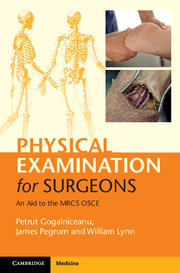Book contents
- Frontmatter
- Dedication
- Contents
- List of contributors
- Introduction
- Acknowledgments
- List of abbreviations
- Section 1 Principles of surgery
- Section 2 General surgery
- Section 3 Breast surgery
- Section 4 Pelvis and perineum
- Section 5 Orthopaedic surgery
- Section 6 Vascular surgery
- Section 7 Heart and thorax
- Section 8 Head and neck surgery
- 32 Examination of the ear
- 33 Examination of the nose
- 34 Examination of the throat
- 35 Oral and maxillofacial examination
- 36 Examination of the neck and thyroid
- Section 9 Neurosurgery
- Section 10 Plastic surgery
- Section 11 Surgical radiology
- Section 12 Airway, trauma and critical care
- Index
35 - Oral and maxillofacial examination
from Section 8 - Head and neck surgery
Published online by Cambridge University Press: 05 July 2015
- Frontmatter
- Dedication
- Contents
- List of contributors
- Introduction
- Acknowledgments
- List of abbreviations
- Section 1 Principles of surgery
- Section 2 General surgery
- Section 3 Breast surgery
- Section 4 Pelvis and perineum
- Section 5 Orthopaedic surgery
- Section 6 Vascular surgery
- Section 7 Heart and thorax
- Section 8 Head and neck surgery
- 32 Examination of the ear
- 33 Examination of the nose
- 34 Examination of the throat
- 35 Oral and maxillofacial examination
- 36 Examination of the neck and thyroid
- Section 9 Neurosurgery
- Section 10 Plastic surgery
- Section 11 Surgical radiology
- Section 12 Airway, trauma and critical care
- Index
Summary
Extra-oral examination of the face
Checklist
WIPER
• Good light source. The patient needs to be sitting with neck exposed to the clavicles. Necklaces and glasses must be removed.
• Examine the head from the front, from the sides and from above.
• Compare the left and right sides of the face.
• Look for deviation of midline structures.
Physiological parameters
General facial examination
• First, rule out
• airway compromise
• cervical spine injuries
• scalp, cranial or intracranial injuries
• major haemorrhage
• Facial appearance expression, symmetry, facial muscle palsy or congenital syndromes
• Nutritional status
Inspection
• Skin of all facial structures: scars, masses (tumours), defects (ulcers, lacerations, tissue loss), colour changes (cyanosis, ecchymoses, erythema, pallor)
• Scalp: lacerations, foreign bodies, haematomas, masses
•
• Ears:
• mastoid bruising (Battle's sign) in skull base fractures
• auricle: lacerations, haematomas or avulsions
• external acoustic meatus: blood or CSF
• Eyes:
• periorbital ecchymoses (‘panda eyes’) in skull base fractures
• ‘sunken’ eye (enopthalmos) and diplopia in orbital floor fractures
• swelling of the eyelids
• symmetry of movement
• subconjunctival haemorrhage
• Nose:
• deformity or deviation from midline
• CSF leak
• bleeding
• septal haematomas
• Lips:
• lacerations, haematomas, masses, asymmetry of the mouth
• Parotid and submandibular glands:
• swelling
• Hard tissues:
• loss of bony contours or deformities of facial skeleton
• malocclusion of teeth, prognathism or retrognathism
Palpation
• Skin: temperature, tenderness.
• Soft tissues: tenderness, fluctuance, surgical emphysema:
• eyelids, nose, lips and cheeks
• submandibular region: induration (rule out Ludwig's angina or abscesses)
• Hard tissues: step deformities, irregularities, mobility or tenderness:
• supraorbital ridge and frontal bones
• inferior orbital ridge and lateral orbital ridge
• zygomatic arch
• ramus, angle and body of mandible
• nasal bone, midface, teeth
• Sensation:
• numbness in distribution of infraorbital nerve (cheek and upper lip) in orbital blow-out fracture or zygoma fractures
• numbness in distribution of inferior alveolar nerve (chin and lower lip) in mandibular fractures
• Sinuses: tenderness
• Salivary glands: parotid, submandibular for enlargement and tenderness.
- Type
- Chapter
- Information
- Physical Examination for SurgeonsAn Aid to the MRCS OSCE, pp. 292 - 306Publisher: Cambridge University PressPrint publication year: 2015



